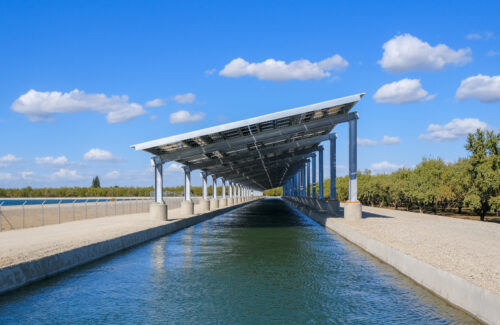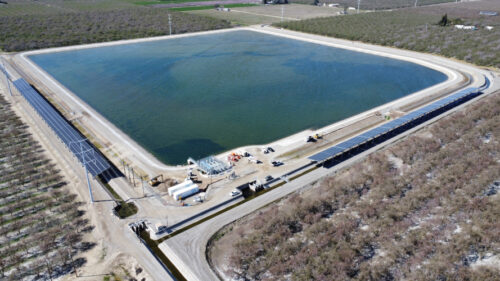The first phase of Project Nexus, a study on integrating renewable energy with water conservation by utilizing solar-covered canals, has been completed and a second phase is well underway.
Project Nexus, led by the University of California, Merced and implemented by the Turlock Irrigation District (TID), explores the potential of solar-covered canals to optimize land use. This innovative approach not only generates clean energy but also reduces water evaporation. The project aims to gather critical data on energy production, water savings and operational efficiency, setting the stage for future large-scale implementations.
The benefits of solar-covered canals extend well beyond energy production. Research suggests that covering California’s canals with solar panels could save 63 billion gallons of water annually — enough to supply 2 million people per year. Additional advantages include:
- Reducing algae growth in the canals by blocking sunlight exposure.
- Generating clean electricity while using existing infrastructure.
- Minimizing land use conflicts, preserving farmland and natural ecosystems.
- Helping regulate solar panel temperatures.
Since its launch, Project Nexus has made substantial progress in demonstrating the viability of solar-over-canal technology. The first phase, covering a narrow canal section, is operational and already generating electricity, demonstrating the structural and energy-producing potential of this model. Now, the project is scaling up with the installation of solar panels over a much wider canal span, further testing its adaptability.
One of the companies supporting this progress is experienced renewable energy contractor BEI Construction. BEI is responsible for the electrical integration of the project, applying field-proven expertise to ensure a seamless and efficient installation.
The project also introduces unique challenges, especially for BEI’s safety team, as working over water requires new protocols compared to land-based solar farms. One major challenge is adapting engineering solutions to a canal system that stretches 250 miles, where varying widths demand different structural approaches. The second phase alone expands from 20 ft in the first phase to 110 ft wide, requiring customized installation methods.
Additionally, safety is a top priority — crews must navigate over-water construction, implementing specialized precautions such as work platforms, fall protection systems and advanced electrical safety measures to ensure a secure installation environment.
“At BEI Construction, we take pride in solving complex infrastructure challenges. Our work on Project Nexus reflects our commitment to pushing the boundaries of renewable energy integration while maintaining the highest safety standards,” said Dominic DiMare, CEO of BEI Construction.
With the second phase in progress, Project Nexus is expected to provide invaluable insights into energy production, water savings and operational efficiency. These findings will guide future expansion opportunities and contribute to California’s broader push for sustainable infrastructure solutions.


















